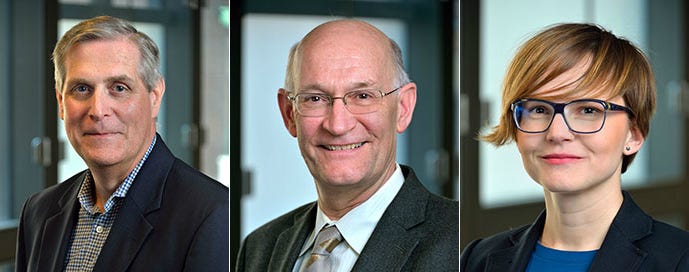Penn and Lehigh Research Team Seeks Alternative Ammonia Production Methods for Sustainable Fertilizers
By Emily Schalk

A Penn Engineering team from the Department of Chemical and Biomolecular Engineering, including John M. Vohs, Carl V. S. Patterson Professor and Chair, Raymond J. Gorte, Russell Pearce and Elizabeth Crimian Heuer Professor, and Aleksandra Vojvodic, Skirkanich Assistant Professor of Innovation, is collaborating with Lehigh University’s Steven McIntosh on research that seeks an alternative production method for ammonia.
“Ammonia is used in lots of things, but especially industrial fertilizer, which makes food production possible on its current scale,” said Vohs. “But it takes a lot of energy to produce ammonia. We’re trying to come up with electrochemical pathways to synthesize ammonia more efficiently.”
The team is looking for a catalyst that they hope will allow them to bypass the widely used but costly Haber Process. Their research has been funded by a three-year collaborative research grant from the National Science Foundation.
“The process of producing ammonia is critical for human survival, hasn’t changed in more than one hundred years and is a big polluter. It’s time for a change,” said McIntosh in Lehigh’s coverage of the research.
Steven McIntosh wants to transform the way ammonia is produced. He hopes to create a viable alternative to the conventional method, which uses massive amounts of energy and emits harmful carbon dioxide. He’s exploring a sustainable electrochemical method to efficiently drive the chemical reaction that produces ammonia.
Ammonia, a colorless gas made out of one nitrogen and three hydrogen atoms, is found only in small quantities in nature. Large quantities of ammonia are produced through what is known as the Haber-Bosch Process — created by German chemists Fritz Haber and Carl Bosch in the early 20th century. It is credited with making mass food production possible, as ammonia’s main industrial use is in agriculture as fertilizer.
The Haber Process, as it’s widely known, combines nitrogen from the air with hydrogen derived from natural gas — comprised mostly of methane — in a chemical reaction that operates at very high pressure. In this conventional method, Iron, the catalyst used, easily “breaks” the hydrogen atoms. However, a huge amount of pressure is required to “push” the nitrogen onto the catalyst to spur the reaction. In addition, the process of generating hydrogen from methane emits large quantities of the greenhouse gas carbon dioxide into the atmosphere.
Continue reading at the Lehigh University News Center.
